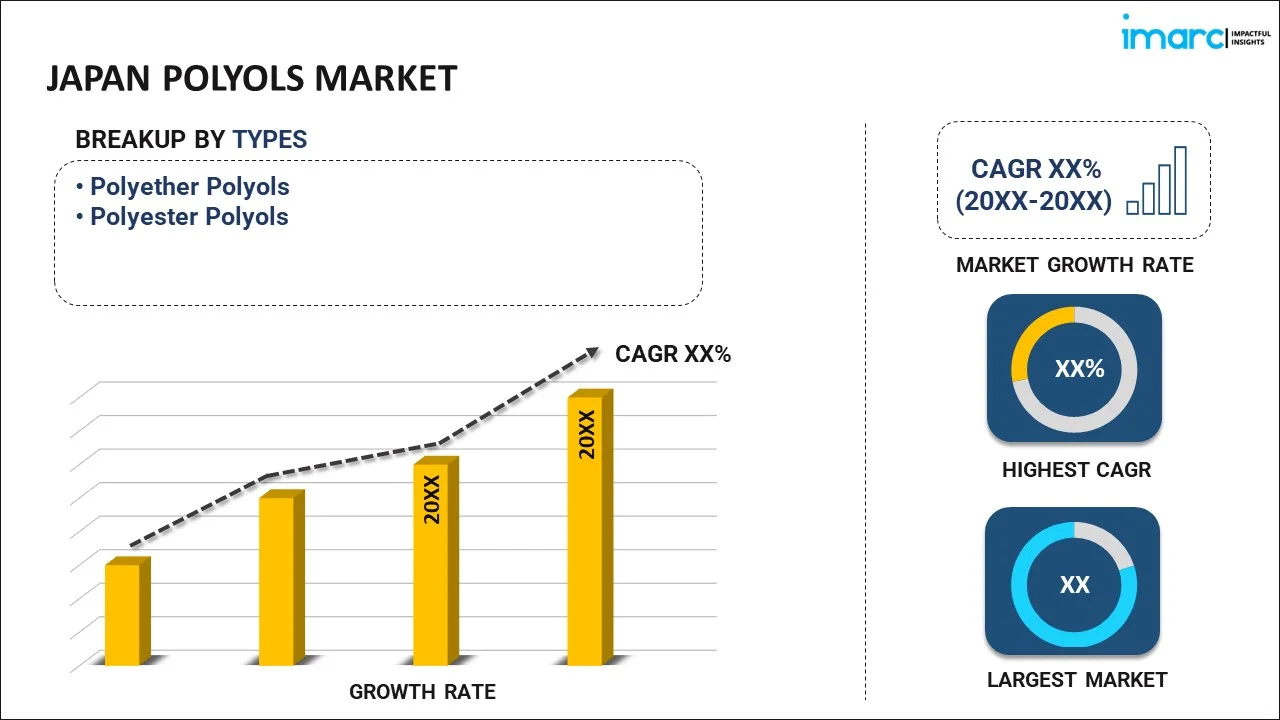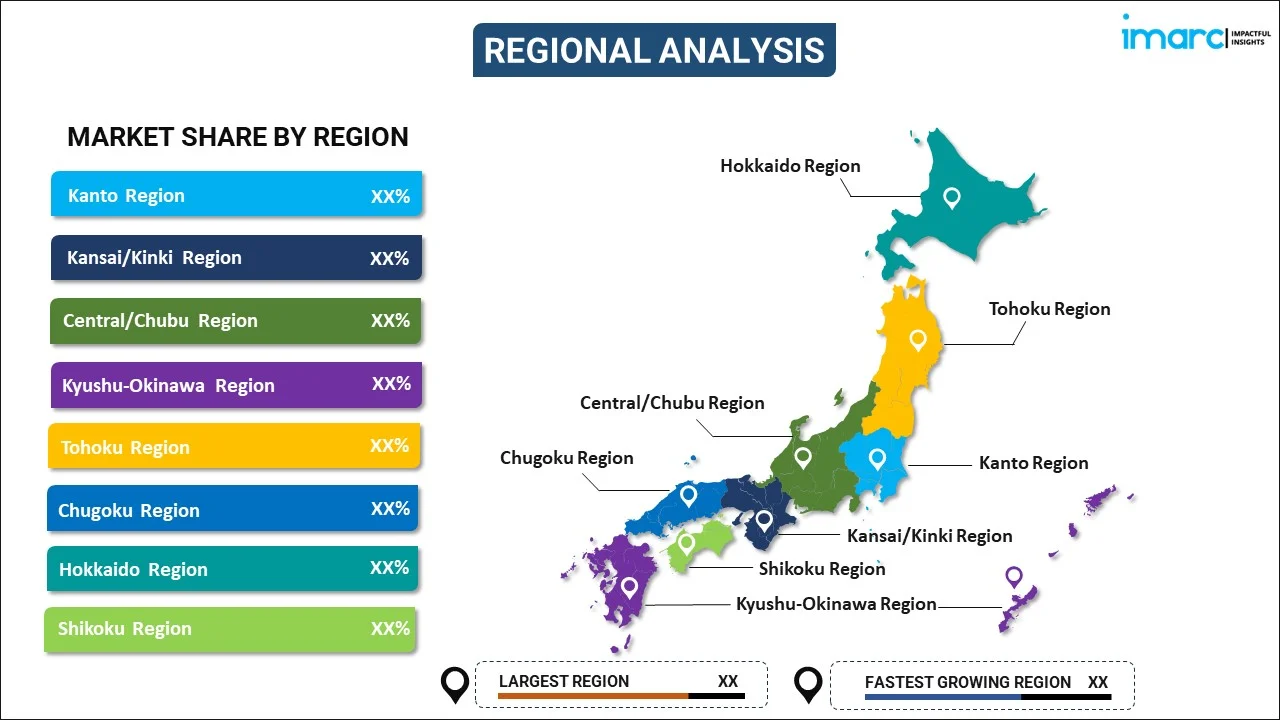
Japan Polyols Market Report by Type (Polyether Polyols, Polyester Polyols), Application (Flexible Polyurethane Foams, Rigid Polyurethane Foams, CASE (Coatings, Adhesives, Sealants and Elastomers), and Others), Industry (Carpet Backing, Packaging, Furniture, Automotive, Building and Construction, Electronics, Footwear, and Others), and Region 2025-2033
Market Overview:
Japan polyols market size reached USD 1.8 Billion in 2024. Looking forward, IMARC Group expects the market to reach USD 2.5 Billion by 2033, exhibiting a growth rate (CAGR) of 4.1% during 2025-2033. The increasing prevalence of construction activities due to urbanization and infrastructure development, which enhances the demand for primary polyols used in the production of polyurethane products, is driving the market.
|
Report Attribute
|
Key Statistics
|
|---|---|
|
Base Year
|
2024
|
|
Forecast Years
|
2025-2033
|
|
Historical Years
|
2019-2024
|
|
Market Size in 2024
|
USD 1.8 Billion |
|
Market Forecast in 2033
|
USD 2.5 Billion |
| Market Growth Rate 2025-2033 | 4.1% |
Polyols, or polyhydric alcohols, are a group of chemical compounds characterized by multiple hydroxyl (OH) groups. These versatile substances find widespread application in various industries, including food, pharmaceuticals, and polymers. Common examples of polyols include sorbitol, mannitol, and xylitol. In the food industry, polyols serve as sugar substitutes due to their sweet taste without causing a rapid increase in blood sugar levels. Additionally, they contribute to product texture and moisture retention as well as act as bulking agents. In pharmaceuticals, polyols are used in drug formulations and as excipients. In the polymer industry, polyols are crucial components in the production of polyurethanes, contributing to the material's flexibility and durability. As industries continue to explore sustainable alternatives, polyols are also gaining attention for their potential use in environmentally friendly products.
Japan Polyols Market Trends:
The polyols market in Japan is experiencing robust growth, primarily driven by increasing consumer awareness of health-conscious choices and a rising demand for low-calorie sweeteners. Furthermore, the surge in diabetic and obese populations has led to a growing preference for sugar alternatives, positioning polyols as a viable solution. Additionally, the escalating prevalence of lifestyle-related diseases has prompted a shift towards healthier food options, propelling the polyols market forward. Moreover, advancements in food technology and the development of innovative products are amplifying the application of polyols in various industries. The multifunctionality of polyols as sugar substitutes, humectants, and bulking agents has heightened their appeal, contributing to their expanding market presence. Simultaneously, governmental regulations promoting the use of polyols in food and pharmaceuticals have played a pivotal role in shaping the market landscape. Furthermore, the polyols market is witnessing an upsurge in R&D activities, fostering the discovery of new formulations and applications. As consumer preferences continue to evolve towards natural and organic products, the market is adapting by incorporating bio-based polyols, thereby creating a sustainable and eco-friendly dimension to its growth trajectory. In essence, a confluence of health-conscious trends, technological advancements, regulatory support, and sustainable innovations is propelling the polyols market in Japan during the forecast period.
Japan Polyols Market Segmentation:
IMARC Group provides an analysis of the key trends in each segment of the market, along with forecasts at the country level for 2025-2033. Our report has categorized the market based on type, application, and industry.
Type Insights:

- Polyether Polyols
- Polyester Polyols
The report has provided a detailed breakup and analysis of the market based on the type. This includes polyether polyols and polyester polyols.
Application Insights:
- Flexible Polyurethane Foams
- Rigid Polyurethane Foams
- CASE (Coatings, Adhesives, Sealants and Elastomers)
- Others
A detailed breakup and analysis of the market based on the application have also been provided in the report. This includes flexible polyurethane foams, rigid polyurethane foams, CASE (Coatings, Adhesives, Sealants and Elastomers), and others.
Industry Insights:
- Carpet Backing
- Packaging
- Furniture
- Automotive
- Building and Construction
- Electronics
- Footwear
- Others
The report has provided a detailed breakup and analysis of the market based on the industry. This includes carpet backing, packaging, furniture, automotive, building and construction, electronics, footwear, and others.
Regional Insights:

- Kanto Region
- Kansai/Kinki Region
- Central/ Chubu Region
- Kyushu-Okinawa Region
- Tohoku Region
- Chugoku Region
- Hokkaido Region
- Shikoku Region
The report has also provided a comprehensive analysis of all the major regional markets, which include Kanto Region, Kansai/Kinki Region, Central/ Chubu Region, Kyushu-Okinawa Region, Tohoku Region, Chugoku Region, Hokkaido Region, and Shikoku Region.
Competitive Landscape:
The market research report has also provided a comprehensive analysis of the competitive landscape. Competitive analysis such as market structure, key player positioning, top winning strategies, competitive dashboard, and company evaluation quadrant has been covered in the report. Also, detailed profiles of all major companies have been provided.
Japan Polyols Market Report Coverage:
| Report Features | Details |
|---|---|
| Base Year of the Analysis | 2024 |
| Historical Period | 2019-2024 |
| Forecast Period | 2025-2033 |
| Units | Billion USD |
| Scope of the Report | Exploration of Historical and Forecast Trends, Industry Catalysts and Challenges, Segment-Wise Historical and Predictive Market Assessment:
|
| Types Covered | Polyether Polyols, Polyester Polyols |
| Applications Covered | Flexible Polyurethane Foams, Rigid Polyurethane Foams, CASE (Coatings, Adhesives, Sealants and Elastomers), Others |
| Industries Covered | Carpet Backing, Packaging, Furniture, Automotive, Building and Construction, Electronics, Footwear, Others |
| Regions Covered | Kanto Region, Kansai/Kinki Region, Central/ Chubu Region, Kyushu-Okinawa Region, Tohoku Region, Chugoku Region, Hokkaido Region, Shikoku Region |
| Customization Scope | 10% Free Customization |
| Post-Sale Analyst Support | 10-12 Weeks |
| Delivery Format | PDF and Excel through Email (We can also provide the editable version of the report in PPT/Word format on special request) |
Key Questions Answered in This Report:
- How has the Japan polyols market performed so far and how will it perform in the coming years?
- What has been the impact of COVID-19 on the Japan polyols market?
- What is the breakup of the Japan polyols market on the basis of type?
- What is the breakup of the Japan polyols market on the basis of application?
- What is the breakup of the Japan polyols market on the basis of industry?
- What are the various stages in the value chain of the Japan polyols market?
- What are the key driving factors and challenges in the Japan polyols?
- What is the structure of the Japan polyols market and who are the key players?
- What is the degree of competition in the Japan polyols market?
Key Benefits for Stakeholders:
- IMARC’s industry report offers a comprehensive quantitative analysis of various market segments, historical and current market trends, market forecasts, and dynamics of the Japan polyols market from 2019-2033.
- The research report provides the latest information on the market drivers, challenges, and opportunities in the Japan polyols market.
- Porter's five forces analysis assist stakeholders in assessing the impact of new entrants, competitive rivalry, supplier power, buyer power, and the threat of substitution. It helps stakeholders to analyze the level of competition within the Japan polyols industry and its attractiveness.
- Competitive landscape allows stakeholders to understand their competitive environment and provides an insight into the current positions of key players in the market.
Need more help?
- Speak to our experienced analysts for insights on the current market scenarios.
- Include additional segments and countries to customize the report as per your requirement.
- Gain an unparalleled competitive advantage in your domain by understanding how to utilize the report and positively impacting your operations and revenue.
- For further assistance, please connect with our analysts.
 Inquire Before Buying
Inquire Before Buying
 Speak to an Analyst
Speak to an Analyst
 Request Brochure
Request Brochure
 Request Customization
Request Customization




.webp)




.webp)












